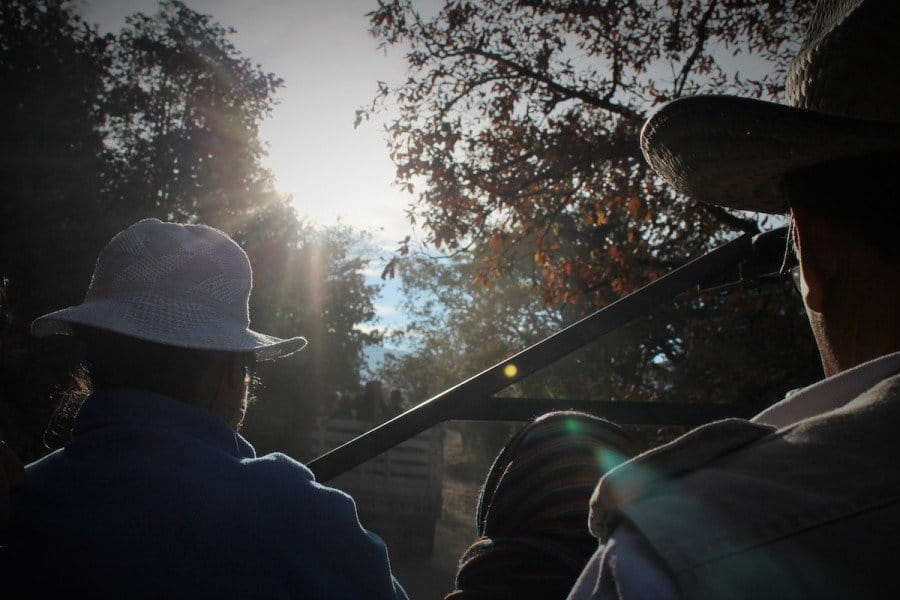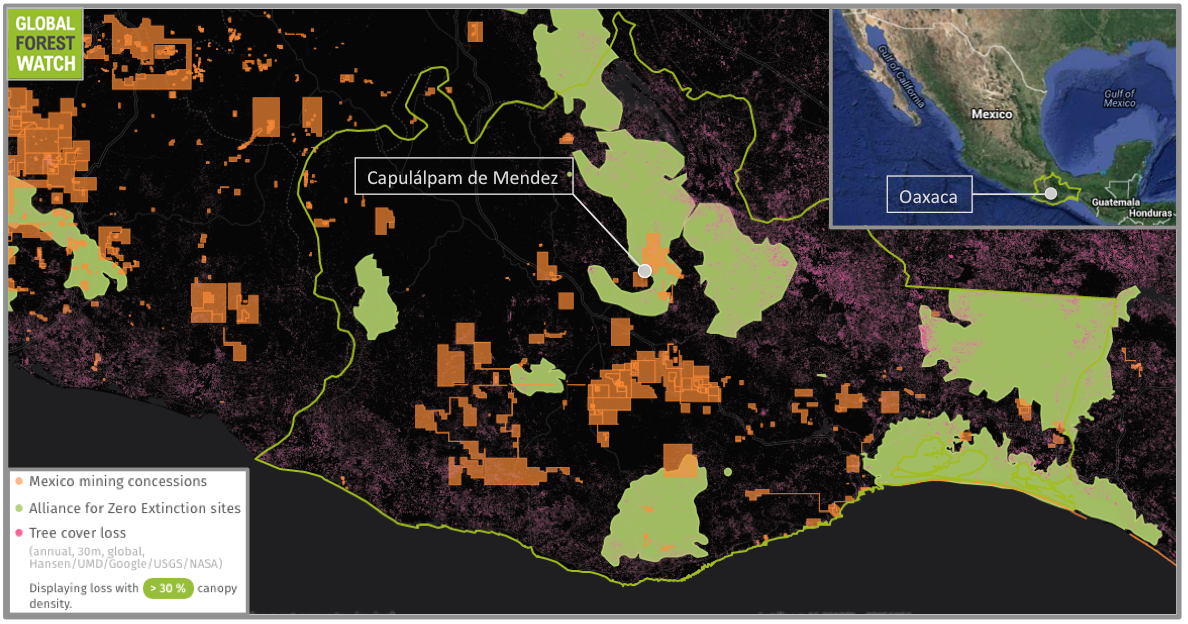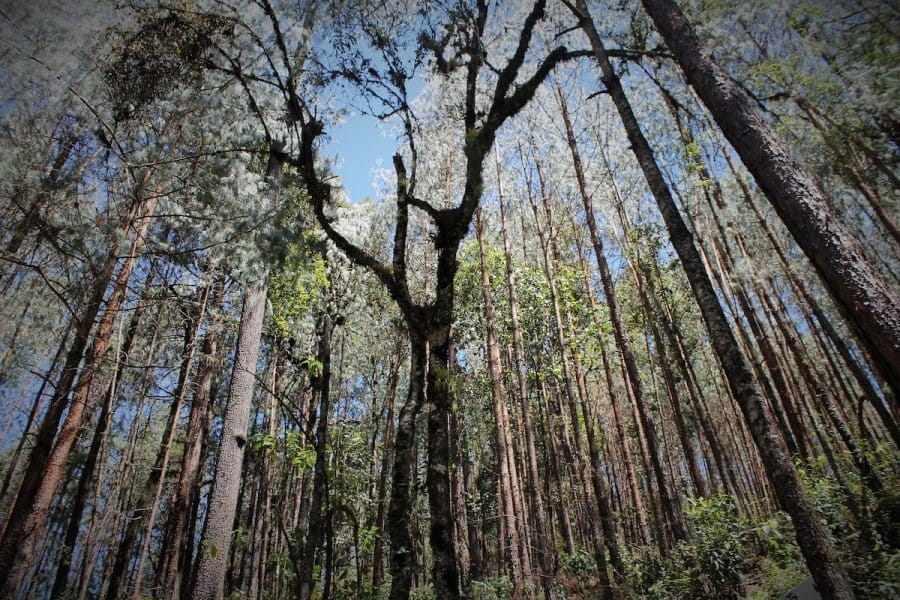- Mexico is known internationally for its environmental achievements. It is a pioneering country in Community Forestry Management (CFM), biodiversity protection, Payments for Environmental Services (PES) and climate change policy. This past year, Mexico was one of the first countries to complete its Intended Nationally Determined Commitments (INDCs) for the Paris climate talks.
- Yet civil society organizations in Mexico have rung the alarm that these achievements are at risk due to intensified exploration and production in the mining and hydrocarbon sectors. Passed in 2014, sweeping energy reforms have opened up huge swaths of the national territory to energy prospecting. There are 888 currently active mining projects, making Mexico’s mining industry the fourth largest in the world.
- Many of these concessions overlap with protected areas and areas of social land tenure that local communities have managed and depended upon for generations.
Forty women, a few small children, and one adventurous dog pile into pick-up trucks parked in the town square. It is an early Saturday morning in March in the small mountain town of Capulálpam de Mendez in Oaxaca, Mexico. Mist hangs over the mountains that ring the town center, 45 miles from the state capital.
Capulálpam, home to 2,500 people, feels distant from the city, with no cell phone service and transportation out of town ending at six each evening. Capulálpam’s residents are Zapotecs, one of the many indigenous groups in the southern Mexican state of Oaxaca.
Capulálpam’s territory, governed under the common property system established after the Mexican Revolution, comprises of 4,500 hectares. We drive nine miles into the pine forest.
Reaching our destination in the forest, the town mayor, Saúl Aquino, explains that we are in the community’s protected area, where no one is allowed to fell trees or extract other resources. Aquino points out the adjoining reforestation area, where trees have been planted to replace those logged in the sustainable forestry program.
Rosita López Martinez, a young woman from Capulálpam who works in environmental education, points out birds flitting around in the forest around us. She begins to hand out pamphlets that describe the birds found in Oaxaca.
“Songbirds are a biodiversity indicator,” she said. “When we see these different types of birds, we know our forest is healthy.”



Aquino adds that we are close to the springs that supply fresh water for the town. While most Mexicans have to drink bottled water due to sanitation problems, Aquino notes, “We should be very proud that here in Capulálpam, we can open the tap and drink our very own spring water.”
Aquino continues, “Here in the community we have designated our protected area, our sustainable forestry area, our agricultural area.” Capulálpam is also in Mexico’s REDD+ Early Action Area and receives Payments for Environmental Services from the federal government.
But the region has also attracted the attention of industry, specifically because of its underlying gold and silver deposits. Showing a map to the group, Aquino says, “The federal government has given titles for all of our territory to foreign mining companies.”
Contradictions in Mexican conservation policy
Mexico is known internationally for its environmental achievements. It is a pioneering country in Community Forestry Management (CFM), biodiversity protection, Payments for Environmental Services (PES) and climate change policy. This past year, Mexico was one of the first countries to complete its Intended Nationally Determined Commitments (INDCs) for the Paris climate talks.
Yet civil society organizations in Mexico have rung the alarm that these achievements are at risk due to intensified exploration and production in the mining and hydrocarbon sectors. Sweeping energy reforms are a cornerstone of President Enrique Peña Nieto’s administration. Passed in 2014, the reforms have allowed foreign investment in the energy sector for the first time since the industry was nationalized in the 1930s, following the Mexican Revolution. The highly controversial reforms opened up huge swaths of the national territory to energy prospecting.
Since 2014, the federal government has awarded 489 hydrocarbon concessions for exploration, extraction and production, covering a total of 11.4 million hectares – an area larger than the U.S. state of Virginia. Additionally, 37 million hectares nationwide are now divided between 33,303 mining titles, covering 18.8 percent of Mexico’s landmass. There are 888 active mining projects, making Mexico’s mining industry the fourth largest in the world.
One implication of these titles that is attracting the concern of conservationists is that they frequently overlap with natural protected areas.
“The federal government designates conservation areas and at the same time they promote some of the most polluting industries out there,” said Daniel Sandoval, of the Mexico City-based organization Center for Studies of Change in the Mexican Countryside (CECCAM), in an interview with Mongabay.
Selling off Mexico’s national parks
A full 10 percent of the surface area of natural protected areas in Mexico has been granted in mining titles, according to a recent study by Mexican biologist Elisa Jeanneht Armendariz-Villegas.
In total there are 2,542 mining titles within the limits of federal natural protected reserves. These concessions cover over 2.7 million hectares in 75 different national protected areas.

Mexico has one of the most extensive Payments for Ecosystem Services (PES) programs worldwide, which provide incentives to landowners in exchange for preserving ecosystem services on their properties. But according to data from CECCAM, there are currently 6,453 mining concessions overlapping with 5.1 million hectares that are eligible for PES. Mexico is also aggressively developing its national Reducing Emissions from Deforestation and Forest Degradation (REDD+) program, which aims to enhance forest management in developing countries. Yet within the Early Action Areas for REDD+ more than 2.6 million hectares have been titled for mining.
Under the Law of Ecological Equilibrium and Environmental Protection, Mexico’s primary environmental legislation, mining or hydrocarbon extraction can take place within protected reserves if the environmental secretary issues a permit based on an environmental impact assessment. The exploitation must take place, “without deteriorating the ecosystem, changing the landscape in a significant way, or causing irreversible environmental impacts,” according to the policy. The national Mining Law also indicates that mining within protected areas, “Can only take place with the authorization or permission of the authorities who are in charge of the area.”
Even though proposed mining projects in protected areas must pass an environmental assessment, Armendariz-Villegas argues, “Mining, especially large-scale, is definitely not a low-impact activity.”
The Mexican government claims that the overlap is incidental and that protected areas will not be impacted, according to Daniel Sandoval who authored a recently published report that documents mining and hydrocarbon titles in protected areas and indigenous territories. In an interview with Mongabay, he said, “Our question is, if that’s true, why put the protected areas at risk in the first place?”
Government officials did not respond to interview requests. Margarita Lozada Nava, an Environmental Director in the Economy Secretary, stated in a publicly-available PowerPoint presentation that, “Open dialogue promotes more opportunities to reach agreements that seek a balance between using natural resources and protecting the environment.”
Oaxaca: local communities protect biodiversity
Oaxaca is a key state in Mexican conservation initiatives. It has some of the largest extensions of temperate and tropical forests and some of the highest biodiversity levels in the country. It is also home to pioneering Community Forestry Management (CFM) projects that have allowed local communities to generate income and employment from sustainable timber harvests.

Seventy-eight percent of Oaxaca is held under communal land tenure. After the Mexican Revolution of the early 20th century, the new government carried out the most extensive land re-distribution of its time in Latin America. Indigenous communities that had continually occupied their territories were granted legal titles and referred to as “agrarian communities.” People who petitioned the government and received land were organized into “ejidos.” Residents of both ejidos and agrarian communities, together known as social land tenure, are organized in assemblies that decide political issues for the community.
Agrarian communities and ejidos have the legal right to decide land uses within their territory. However, this right is limited, as the federal government holds the mineral rights to the land and the right to regulate timber extraction.
This complicated legal situation has contributed to a level of distrust that exists in some communities towards state-led conservation efforts. In addition to the communities that have entered into federal or state natural protected areas, many communities have adopted their own local systems to conserve their natural resources. Such is the case of Capulálpam, where the community assembly has designated a protected reserve, but it is not certified with the national reserves system.
The hesitance to enter federal conservation programs stems from both the restrictions placed on communities in federal reserves, and the loss of decision-making power over issues such as mining. Sandoval insists that the efforts of indigenous communities to protect their lands must be respected, instead of handing over more control to federal conservation programs.
“The most important work to conservation natural resources in Mexico has been done by indigenous communities,” he said. “The government takes credit for the work indigenous communities have done for centuries to preserve their territories.”
There are currently 416 active mining concessions in Oaxaca, covering a total of 472 thousand hectares, or 8 percent of the state’s territory. Eighty percent of these concessions are within areas of social land tenure. Oaxaca has ten federal protected areas; two now have mining concessions.
Capulálpam: the mining town that placed its bets on conservation
Capulálpam has received accolades for its sustainable forestry and forest conservation practices over the past two decades. Yet gold and silver mining is at the heart of the community’s history, going back to the 1700s when Spaniards started to extract minerals with the local labor force.
This history is recognized with a statue of a miner outside the town hall. A government tourism initiative called “Magic Towns” has brought more services, restaurants and WiFi hotspots to the town over the past seven years, but much of life remains the same: eating hand-made corn tortillas, sharing the traditional mezcal alcohol made from the agave plant and heaping plates of yellow mole made from tomatoes and chihuacle chilies at festivals.


Community members are concerned that re-opening and expanding the mines will threaten this lifestyle and their conservation initiatives.
“The old mining was very basic, with pickaxes and hand-operated machines, but now it would be modern mining,” said Capulálpam mayor Saul Aquino. “What they extracted over 200 years, now they would be able to extract over just ten or fifteen years.”
The small community of Natividad, which neighbors Capulálpam, was the site of the original mines. Production dwindled for decades and the mines finally closed in the 1990s.
The local community had begun to oppose the mining due to health and environmental impacts, despite its important place in the local economy. Elders in Capulálpam confirmed what they had witnessed for several years: at least thirteen aquifers located across the communal territory had disappeared gradually over the course of the last 40 years. Gold and silver extraction require vast amounts of water, and the mine had been drawing off the community aquifers for more than two centuries.
In 2003, Capulálpam residents learned that the Canadian Natividad Company was carrying out exploratory activities in their territory. This was happening without consultation with Capulálpam residents, a right for indigenous communities under Mexican and international law. Without the community’s consent, the federal government had concessioned its entire territory to mining companies. The community assembly succeeded in halting the activities because the company was not permitted and had not carried out a local consultation.
After changes to the Law of Foreign Investment in 1996, foreign companies are now allowed to invest in mining with no restrictions and hold one hundred percent of mining assets. The Vancouver-based Continuum Resources Group mining company bought Natividad and continues to pursue mining activities in the community.
Aquino has been directly involved in the movement against the mining. “Yes, we want jobs and we want investment,” he said, “but we want jobs and investment that don’t destruct the environment.”

The community assembly of Capulálpam has lodged a legal challenge against the mining companies, which have been barred from any further activities for the time being. Despite Capulálpam’s achievements in sustainable forestry and biodiversity conservation, international mining companies, with the support of the federal government, remain poised to enter their territory.
Civil society responds to mining boom in Mexico
Capulálpam is one of numerous communities in Mexico that have used legal channels to halt or end mining activity. Communities confronting airport, highway and pipeline construction have also used similar strategies. As more indigenous groups in Mexico become familiar with their rights under the U.N. Declaration on the Rights of Indigenous Peoples and the ILO Convention 169, these legal challenges become more common.
CECCAM and other civil society organizations work with local communities to understand their rights and take action.
“The government puts forward an image that it is a government that respects human rights, an ecologically-minded government,” Sandoval said. “It has been difficult to make visible and public what is really happening in the country.”
The issue has garnered little attention outside Mexico. Conservation projects in the country receive funding from a bevy of international conservation organizations, notably The Nature Conservancy and Conservation International. They have been quiet on the issue of mining and hydrocarbon concessions, including in regions where they implement projects, such as the Calakmul Biosphere Reserve.
“It would help if some of the international funders would talk about these contradictions in government policy,” Sandoval said. “There is documentation on these issues, but some funders aren’t well-informed.”
Communities such as Capulálpam have faced the encroachment of mining activities face-on, maintaining an opposition movement for more than a decade. Yet conservationists working in the region say action is needed at the national level to slow the tide of mining concessions impacting natural protected areas and indigenous communities.
“It should be a priority to give a legal basis to the cancellation of mining concessions that have already been designated in natural protected areas,” Armendariz-Villegas writes, “and to stop giving away more of these concessions.”